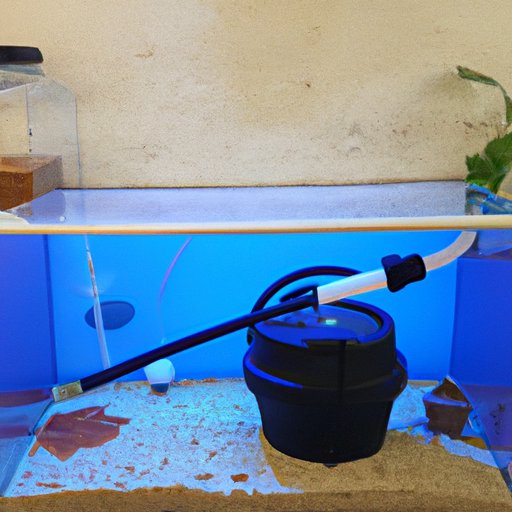Introduction
Fish tanks are one of the most popular pets around the world. According to a 2017 survey by the American Pet Products Association, there are about 2.6 million households in the United States alone that have fish tanks. From novice hobbyists to experienced aquarists, starting a fish tank can be both a fun and rewarding experience.
This article will provide an overview of the process of starting a fish tank, from gathering supplies to introducing fish and other aquatic life. By following these steps, you’ll be able to create a safe and healthy environment for your fish and other aquatic life.
Gather the Necessary Supplies
The first step in starting a fish tank is to gather the necessary supplies. This includes items such as a tank, filter, heater, substrate, decorations, and plants. It’s important to choose high-quality supplies that are designed specifically for fish tanks. For example, when selecting a tank, make sure it has a good sealing lid to prevent any leaks and is made of durable materials.
When shopping for supplies, it’s also important to take into account the size of the tank, the type of fish you plan to keep, and the amount of maintenance required. Additionally, it’s helpful to read reviews from other aquarists to get an idea of which products are the best for your needs.

Choose the Right Location for Your Fish Tank
Once you’ve gathered the necessary supplies, the next step is to choose the right location for your fish tank. Ideally, you should select a spot that is away from direct sunlight and other sources of heat. This will help keep the water temperature stable, which is essential for the health and wellbeing of your fish.
It’s also important to select a spot that is not prone to vibrations or loud noises, as this can cause stress for the fish. Additionally, you should avoid placing the tank near windows or doors that open and close frequently, as this can disrupt the balance of the ecosystem in the tank.
Clean and Prepare the Tank
Before adding water to the tank, it’s important to clean and prepare it properly. This includes rinsing the tank, substrate, decorations, and plants with warm water to remove any dirt or debris. You should also scrub the inside of the tank to ensure there are no contaminants left behind.
It’s also important to check the pH level of the tank and adjust it if necessary. The optimal pH level for most fish tanks is between 6.5 and 8.0. If the pH level is too low or too high, it can cause stress for the fish and other aquatic life in the tank.
Install the Filtration System
Once the tank is clean and prepared, the next step is to install the filtration system. There are several different types of filtration systems available, including mechanical, chemical, and biological. Mechanical filters remove solid particles from the water, while chemical filters remove dissolved organic compounds. Biological filters, on the other hand, use beneficial bacteria to break down waste.
When installing the filtration system, it’s important to follow the manufacturer’s instructions carefully. Additionally, it’s helpful to place the filter in an area of the tank where it won’t be disturbed by other aquatic life.

Add Water to the Tank
Once the filtration system is installed, you can begin to add water to the tank. It’s important to choose the right type of water for your tank, such as dechlorinated tap water or reverse osmosis water. Additionally, you should test the water to make sure it has the proper pH and other parameters before adding it to the tank.
When adding the water to the tank, it’s important to do it slowly and evenly. This will help prevent any shock to the fish or other aquatic life in the tank. Additionally, it’s helpful to use a water conditioner to remove chlorine and other harmful compounds from the water.

Introduce Fish and Other Aquatic Life
Once the tank is set up, you can begin to introduce fish and other aquatic life. When selecting fish, it’s important to choose species that are compatible with each other and that require similar water parameters. Additionally, it’s helpful to research the specific needs of each species before introducing them to the tank.
It’s also important to introduce new fish and other aquatic life slowly. This will help prevent any sudden changes in the tank’s chemistry, which can be harmful to the fish. Additionally, it’s helpful to keep an eye on the tank for the first few weeks to make sure everything is going smoothly.
Conclusion
Starting a fish tank can be a fun and rewarding experience. By following these steps, you can create a safe and healthy environment for your fish and other aquatic life. From gathering the necessary supplies to introducing fish and other aquatic life, the process of setting up a fish tank can seem daunting at first. However, with careful planning and preparation, you can create a beautiful and thriving aquarium for years to come.
(Note: Is this article not meeting your expectations? Do you have knowledge or insights to share? Unlock new opportunities and expand your reach by joining our authors team. Click Registration to join us and share your expertise with our readers.)
